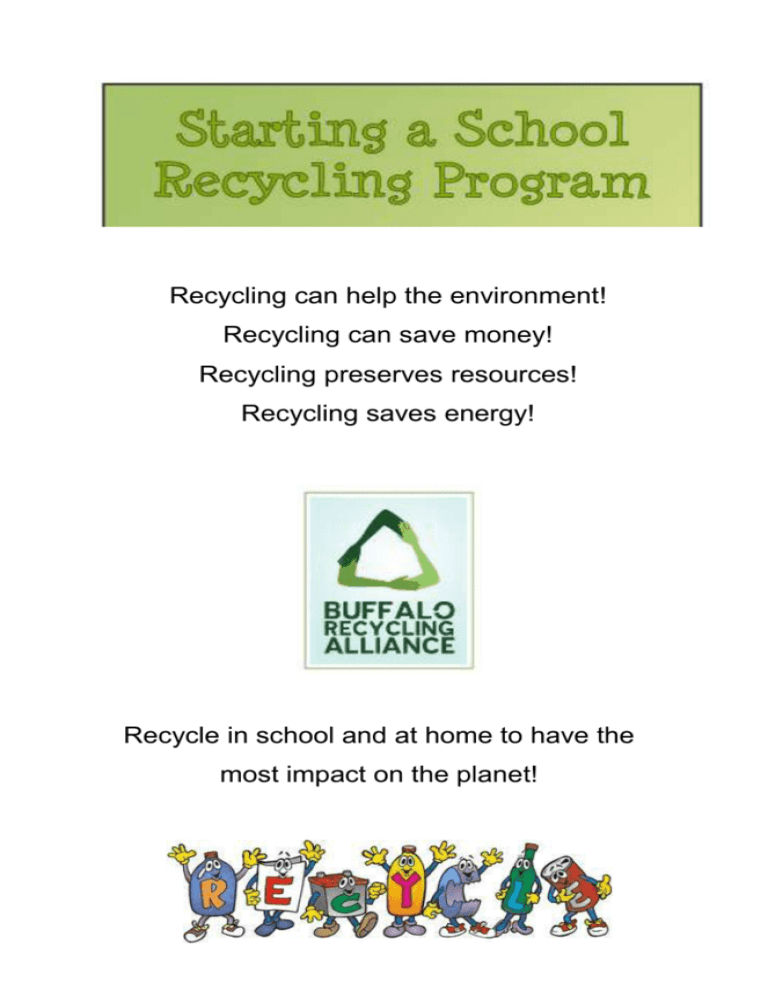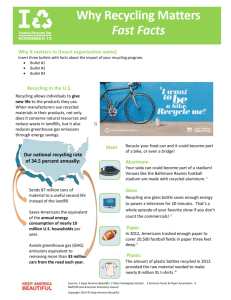1. Building a “Green Team” - Partnership for the Public Good (PPG
advertisement

Recycling can help the environment! Recycling can save money! Recycling preserves resources! Recycling saves energy! Recycle in school and at home to have the most impact on the planet! 1. Building a “Green Team” The Green Team is responsible for coordinating all aspects of your school’s recycling and waste reduction program. The following is a list of tips for starting and maintaining an effective Green Team. 1. Select an enthusiastic and organized staff member to be the team leader. Your team should consist of a school administrator, teachers, the head custodian, students from every grade level, parents, PTA representative and the food service company. 2. Clearly define roles and responsibilities of the Green Team members. The team is responsible for the development, implementation and evaluation of the school’s recycling program. 3. Schedule regular meetings to discuss necessary tasks and progress. It is important to communicate your plan of action and on-going program results to your school and district administrators in order to gain and maintain their support. 4. Determine who needs to attend the meetings by setting an agenda. Some representatives, such as food service, only need to be present when discussing food preparation elements. 2. Identifying Recyclables Before you begin your waste assessment, refer to the checklist to determine what types of materials can be recycled in Buffalo and to make note of which materials are generated at your school. CAN BE RECYCLED: PAPER White & Colored Paper Copy/Fax Paper White & Manila Envelopes Newspapers Cardboard Magazines & Catalogs File Folders Glossy Paper Paperboard Phone Books Pizza Boxes (no food) CONTAINERS Must be rinsed or empty Plastic Drink Bottles (#s 1-7) Milk and Juice Cartons (check with hauler) Aluminum Cans Steel & Tin Cans Glass Bottles & Jars Disposable Aluminum Containers CAN NOT BE RECYCLED: PAPER CUPS CHIP BAGS or PLASTIC FOOD WRAP STYROFOAM PLASTIC PLATES OR UTENSILS WOOD 3. Waste Assessment A helpful tool for this step is the School Recycling Survey prepared by the Buffalo Recycling Alliance, included in this kit. 1. Determine what waste is generated at your school. It is important to know what type of waste is produced, how much of each type of waste is produced, and the source of such waste. For example: How many plastic bottles do students and teachers use? Are there a lot of bottles in garbage cans? 2. Document the types of waste that are generated in each area of the school. Classrooms, administrative offices, hallways, the library, sports fields, and the cafeteria are all going to have different types of waste. Assessments should be performed periodically as part of an ongoing evaluation of the success of the recycling program. This is called “tracking” and is explained in greater detail in step 8. 3. Make a list of existing waste containers. This will help determine how many of what type of containers are needed for recycling. This will be useful for step 5: Bin Procurement and Placement. 4. Recyclables Hauling Services The Buffalo Public School District has a collective bid for garbage disposal. This contract is managed through the Buildings and Grounds Department. Each school has a dumpster for garbage. The recycling at the schools in done in one of three ways: 1. Dumpster provided by the garbage hauler for paper, cardboard and co-mingled containers. 2. 95 gallon totes provided by Cascades Recovery for the collection of cardboard and paper only. 3. 95 gallon totes provided by the City of Buffalo Green Tote program for paper, cardboard and co-mingled containers. The Recycling Program used by each school is determined through the school principal and engineer. Other materials to be recycled including hazardous and electronic waste, should be disposed of properly. The resources page at the end of the booklet provides information for such recycling venues. 5. Bins, Decals & Signage Your waste assessment will provide you with the information you need to develop a collection plan that will include types, quantities and locations of the waste containers. For easy identification, it is recommended that you color-code your waste bins. Recycling Bin Selection and Placement 1. Once you have chosen an option for your school’s recycling program, consider repurposing existing equipment or even making your own containers. If your school needs additional waste containers, use the resource page for more information. 2. Place waste and recycling bins next to each other to reduce contamination. The following are recommendations for your consideration. Decals and Signage 1. Make bins easy to tell apart using decals and informational poster. The posters should be used to tell people what can be recycled. 2. Use pictures and color-code your decals and signage to coordinate with your waste bins. Below are some examples of simple decal and signage ideas. 3. Check the condition of signs and decals periodically to be sure they are visible and in good condition at all times. CONTAINERS ONLY Plastic Drink Bottles Aluminum Cans Steel & Tin Cans Glass Bottles & Jars NO STYROFOAM NO PLASTIC PLATES OR UTENSILS PAPER ONLY White & Colored Paper Copy/Fax Paper White & Manila Envelopes Newspapers Cardboard Magazines & Catalogs Pizza Boxes TRASH ONLY 6. Waste Reduction & Reuse A successful school recycling program must include waste reduction and reuse. Such programs save energy, reduce landfill space and usually result in a cost savings. Ways to reduce waste and reuse items include: - Save paper by printing and copying on both sides, reduce spacing, margins, and type size; and eliminate unnecessary copies by utilizing the school’s email system or by sharing documents. - Encourage the use of re-usable lunch bags and water bottles - Host “litter-less” lunch days by encouraging students to eliminate disposable items - Stock the teacher’s lounge with re-usable cups, plates, and utensils - Create a reuse office supply program to eliminate a supply surplus and excess purchasing - Use rechargeable batteries for school equipment - Save and reuse packaging items such as boxes, bags, foam peanuts, and shredded paper - Have your cafeteria switch to reusable trays, utensils and crockery instead of throwaways whenever possible - Start a food scrap composting program outside or take compost to a nearby facility or farm. See resources page for more information on this. 7. Collection & Tracking A successful recycling and waste reduction plan must address the procedure for collecting recyclables and tracking the amount of recyclable materials diverted from your waste. Developing a Collection System Just like trash, recyclables from all areas of your school need to be collected from inside the school and brought outside to the appropriate dumpsters. 1. Involve the students in the collection of recyclables. A combination of rolling carts and bags allow the students to collect the recyclables and bring them to a centralized location inside the school. Typically, the custodians collect the trash and any materials generated in the cafeteria and kitchen. 2. Establish a collection schedule, with rotating responsibilities. The collections can be done before school, during recess periods, or at the end of the day. To minimize classroom disruption, consider the time of day the recyclables are collected. If class is in session, consider having the teachers place their recycling bins outside their classrooms at a predetermined day or time. Tracking Results 1. Maintain records of month-to-month tonnage of recyclables and trash. This information will help you evaluate the success of your program by calculating the schools’ cost/benefit from the increasing volumes of recyclables. 2. Use a bathroom scale to weigh the bins of recyclables or estimate weight as follows: One full tote of paper = 150 pounds, one full tote of cardboard = 50 pounds, and one full tote of co-mingled = 100 pounds. 3. Create a tracking form to record the weight of each recycling bin for each month. 8. Building Awareness Communicate your plans and expectations! This will prompt members of your school to achieve ongoing participation in the recycling program. Education and Training - Provide staff and students with the School’s recycling policy and remind them that everyone is required to participate. - Clearly define what each staff member and students’ role and responsibility will be in the school’s recycling program - Provide ongoing training for all staff and students (Schools may benefit by conducting training by department or grade.) - Assure staff and students that their efforts and feedback will be encouraged, valued, and acknowledged - Include periodic updates and reminders in company emails, memos, newsletters, bulletin boards and morning announcements Publicity Be sure to communicate with members of your school, such as students and parents, as well as the greater community Share the program’s progress, successes, milestones, and special green events/activities when possible Keep members of the school informed through email, morning announcements, bulletin boards, school newspaper and website Involve the community by distributing press releases, inviting the local newspapers to your school during special events, and postings on your website 9. Implementation & Kick-Off Planning a kick-off event is one way to engage the entire school and to help make the new program exciting. Some things to consider as you plan for the official start: - Plan for a scheduled school or district-wide kick-off event to make an official start to your program - The principal of the school should make an announcement of the “official start” of the school’s recycling program - If you are phasing-in parts of your recycling program, be sure to announce future dates for new additions to the program - Involve the entire staff and students from all grade levels - Plan ways to engage the members of your school by having students make a banner for the entry way; wear green for a day; start the day with an environmentally-focused assembly; or encourage teachers to have special green lessons planned for their class - And always remember to lead by example 10. Recognition & Awards Recognize those who are instrumental in the success of the program. Be sure to showcase any recognition or awards given to the school for its green achievements. Such recognition will boost participation and get more people excited. Keep members of your school excited by recognizing them when they “do the right thing”. Consider providing a non-monetary way of recognizing or awarding those involved in the school’s recycling program Hold recycling contests between classes, grades and even teachers Display recycling awards proudly…it is good public relations and will send a positive message to everyone! Resources Recycling Companies Cascades Recovery (716) 681-1560 3241 Walden Avenue Depew, NY 14053 Republic Services of Buffalo, Allied Waste Division (716) 614-3333 2321 Kenmore Ave. Buffalo, NY 14207 Modern (716) 754-8226 4746 Model City Rd. Model City, NY 14107 Waste Management (716) 674-5195 100 Ransier Drive West Seneca, NY 14224 Composting Facilities Community Action Organization (716) 881-5150 70 Harvard Place Buffalo, NY 14209 Massachusetts Avenue Project (716) 816-0961 271 Grant St. Buffalo, NY 14213 E-Waste Recycling Facilities City of Buffalo Engineering Garage 1120 Seneca St. Buffalo, NY 14210 *Open Monday-Friday 8-3pm Other Important Contacts City of Buffalo’s Recycling Coordinator Susan Attridge (716) 851-5014 City Hall #504 Erie County’s Recycling Coordinator Gary Carrell (716) 858-4805 95 Franklin St. Rm # 1080 Buffalo Recycling Alliance Kyla Jaquish (716) 852-4191 ext. 115 237 Main St. Suite 1200 Director of BPS Plant Operations Sue Eager (716) 816-3027 64 Bailey Ave.

![School [recycling, compost, or waste reduction] case study](http://s3.studylib.net/store/data/005898792_1-08f8f34cac7a57869e865e0c3646f10a-300x300.png)



